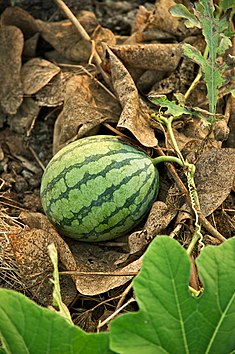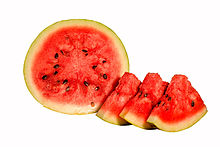Watermelon
| Watermelon | |
|---|---|
 |
|
| Watermelon | |
 |
|
| Watermelon cross section | |
| Scientific classification | |
| Kingdom: | Plantae |
| (unranked): | Angiosperms |
| (unranked): | Eudicots |
| (unranked): | Rosids |
| Order: | Cucurbitales |
| Family: | Cucurbitaceae |
| Genus: | Citrullus |
| Species: | C. lanatus |
| Variety: | lanatus |
| Trinomial name | |
|
Citrullus lanatus var. lanatus (Thunb.) Matsum. & Nakai |
|
 |
|
| Watermelon output in 2005 | |
| Nutritional value per 100 g (3.5 oz) | |
|---|---|
| Energy | 127 kJ (30 kcal) |
|
7.55 g
|
|
| Sugars | 6.2 g |
| Dietary fiber | 0.4 g |
|
0.15 g
|
|
|
0.61 g
|
|
| Vitamins | |
| Vitamin A equiv. |
(4%)
28 μg
(3%)
303 μg |
| Thiamine (B1) |
(3%)
0.033 mg |
| Riboflavin (B2) |
(2%)
0.021 mg |
| Niacin (B3) |
(1%)
0.178 mg |
| Pantothenic acid (B5) |
(4%)
0.221 mg |
| Vitamin B6 |
(3%)
0.045 mg |
| Choline |
(1%)
4.1 mg |
| Vitamin C |
(10%)
8.1 mg |
| Minerals | |
| Calcium |
(1%)
7 mg |
| Iron |
(2%)
0.24 mg |
| Magnesium |
(3%)
10 mg |
| Manganese |
(2%)
0.038 mg |
| Phosphorus |
(2%)
11 mg |
| Potassium |
(2%)
112 mg |
| Sodium |
(0%)
1 mg |
| Zinc |
(1%)
0.1 mg |
| Other constituents | |
| Water | 91.45 g |
| Lycopene | 4532 µg |
|
|
|
|
|
| Percentages are roughly approximated using US recommendations for adults. Source: USDA Nutrient Database |
|
Watermelon (Citrullus lanatus var. lanatus, family Cucurbitaceae) is a vine-like (scrambler and trailer) flowering plant originally from southern Africa. It is a large, sprawling annual plant with coarse, hairy pinnately-lobed leaves and white to yellow flowers. It is grown for its large edible fruit, also known as a watermelon, which is a special kind of berry with a hard rind and no internal division, botanically called a pepo. The fruit has a smooth hard rind—usually green with dark green stripes or yellow spots—and a sweet, juicy interior flesh—usually deep red to pink, but sometimes orange, yellow, or white—with many seeds, which can be soft and white or hard and black.
Considerable breeding effort has been put into disease-resistant varieties and into developing a "seedless" strain with only digestible white seeds. Many cultivars are available, producing mature fruit within 100 days of planting the crop. The fruit can be eaten raw, pickled or the rind cooked.
The watermelon is thought to have originated in southern Africa, where it is found growing wild. It reaches maximum genetic diversity there, with sweet, bland and bitter forms. In the 19th century, Alphonse de Candolle considered the watermelon to be indigenous to tropical Africa.Citrullus colocynthis is often considered to be a wild ancestor of the watermelon and is now found native in north and west Africa. However, it has been suggested on the basis of chloroplast DNA investigations that the cultivated and wild watermelon diverged independently from a common ancestor, possibly C. ecirrhosus from Namibia.
...
Wikipedia
